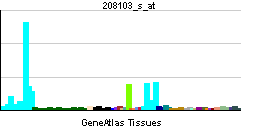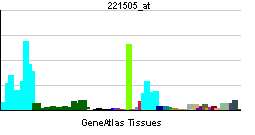ANP32E
| Acidic (leucine-rich) nuclear phosphoprotein 32 family, member E | |||||||||
|---|---|---|---|---|---|---|---|---|---|
| Identifiers | |||||||||
| Symbols | ANP32E ; LANP-L; LANPL; MGC5350 | ||||||||
| External IDs | Template:OMIM5 Template:MGI HomoloGene: 41519 | ||||||||
| |||||||||
| RNA expression pattern | |||||||||
 | |||||||||
 | |||||||||
| More reference expression data | |||||||||
| Orthologs | |||||||||
| Template:GNF Ortholog box | |||||||||
| Species | Human | Mouse | |||||||
| Entrez | n/a | n/a | |||||||
| Ensembl | n/a | n/a | |||||||
| UniProt | n/a | n/a | |||||||
| RefSeq (mRNA) | n/a | n/a | |||||||
| RefSeq (protein) | n/a | n/a | |||||||
| Location (UCSC) | n/a | n/a | |||||||
| PubMed search | n/a | n/a | |||||||
Acidic (leucine-rich) nuclear phosphoprotein 32 family, member E, also known as ANP32E, is a human gene.[1]
References
Further reading
- Matilla A, Radrizzani M (2005). "The Anp32 family of proteins containing leucine-rich repeats". Cerebellum. 4 (1): 7–18. PMID 15895553.
- Maruyama K, Sugano S (1994). "Oligo-capping: a simple method to replace the cap structure of eukaryotic mRNAs with oligoribonucleotides". Gene. 138 (1–2): 171–4. PMID 8125298.
- Suzuki Y, Yoshitomo-Nakagawa K, Maruyama K; et al. (1997). "Construction and characterization of a full length-enriched and a 5'-end-enriched cDNA library". Gene. 200 (1–2): 149–56. PMID 9373149.
- Hartley JL, Temple GF, Brasch MA (2001). "DNA cloning using in vitro site-specific recombination". Genome Res. 10 (11): 1788–95. PMID 11076863.
- Wiemann S, Weil B, Wellenreuther R; et al. (2001). "Toward a catalog of human genes and proteins: sequencing and analysis of 500 novel complete protein coding human cDNAs". Genome Res. 11 (3): 422–35. doi:10.1101/gr.154701. PMID 11230166.
- Jiang M, Ma Y, Ni X; et al. (2003). "Molecular cloning and characterization of a novel human gene (ANP32E alias LANPL) from human fetal brain". Cytogenet. Genome Res. 97 (1–2): 68–71. PMID 12438741.
- Strausberg RL, Feingold EA, Grouse LH; et al. (2003). "Generation and initial analysis of more than 15,000 full-length human and mouse cDNA sequences". Proc. Natl. Acad. Sci. U.S.A. 99 (26): 16899–903. doi:10.1073/pnas.242603899. PMID 12477932.
- Ota T, Suzuki Y, Nishikawa T; et al. (2004). "Complete sequencing and characterization of 21,243 full-length human cDNAs". Nat. Genet. 36 (1): 40–5. doi:10.1038/ng1285. PMID 14702039.
- Gerhard DS, Wagner L, Feingold EA; et al. (2004). "The status, quality, and expansion of the NIH full-length cDNA project: the Mammalian Gene Collection (MGC)". Genome Res. 14 (10B): 2121–7. doi:10.1101/gr.2596504. PMID 15489334.
- Wiemann S, Arlt D, Huber W; et al. (2004). "From ORFeome to biology: a functional genomics pipeline". Genome Res. 14 (10B): 2136–44. doi:10.1101/gr.2576704. PMID 15489336.
- Andersen JS, Lam YW, Leung AK; et al. (2005). "Nucleolar proteome dynamics". Nature. 433 (7021): 77–83. doi:10.1038/nature03207. PMID 15635413.
- Mehrle A, Rosenfelder H, Schupp I; et al. (2006). "The LIFEdb database in 2006". Nucleic Acids Res. 34 (Database issue): D415–8. doi:10.1093/nar/gkj139. PMID 16381901.
| This protein-related article is a stub. You can help Wikipedia by expanding it. |